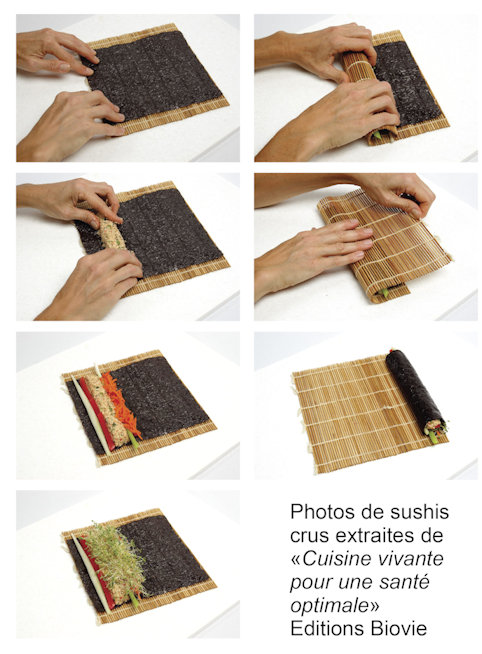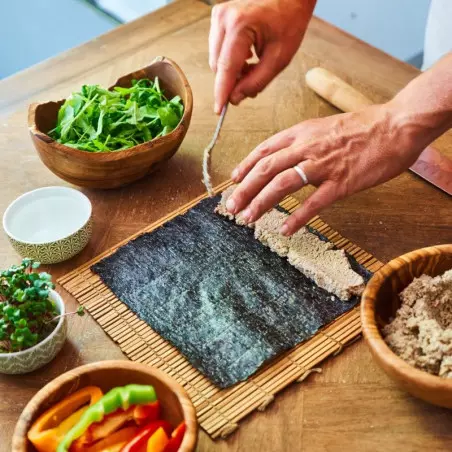What is nori seaweed ?
TheNori seaweed, also known as Porphyra, is part of the red algae family. It is a type of edible dark-colored algae widely used in Asian cuisine in general and particularly in Japanese cuisine. It is a popular ingredient in miso soups and maki rolls, a Japanese dish with great nutritional qualities. Nori algae is typically harvested in the cold and clear waters of the Pacific Ocean and the Atlantic Ocean, making it a staple among edible seaweeds.
These seaweed sheets are very thin, paper-like sheets made from processed seaweed and dried at low temperatures with regard to the algae that we sell (most commercially available nori sheets are dried at high temperatures, which leads to nutrient loss). These sheets are dark green or black in color and have a slightly salty taste. They are generally used in Asian countries, but also in Western countries for a few decades to wrap sushi or maki rolls, thus creating a delicate and crispy outer layer. Nori seaweed sheets can also be used as a garnish or crumbled into small pieces to sprinkle over dishes, enhancing their flavor and visual appeal. They can serve as a base for making homemade seaweed tartare.
It is particularly interesting to note that they are low in calories and fat, making them an excellent option for those looking to maintain a balanced and nutritious diet.
Furthermore, nori seaweed is known for its potential health benefits. It is attributed with antioxidant properties and may help reduce inflammation in the body. Nori seaweed is also believed to promote heart health and strengthen the immune system.
Overall, nori seaweed and nori seaweed sheets are versatile ingredients that offer a unique flavor, texture, and nutritional profile. Whether used in maki rolls, as a topping, or as a healthy snack, nori seaweed adds a delicious and nutritious element to a wide variety of dishes.
How to choose your nori seaweed ?
When choosing nori seaweed, it is important to opt for seaweed dehydrated at low temperatures to preserve its nutritional content as much as possible; these are truly the best sheets in terms of nutrition. Nori seaweed can be found in most organic product stores or Asian supermarkets; it is usually sold in flat sheets, in packages, or in large blocks. Nori seaweed keeps very well, so prioritize packages of 50 sheets for a more economical format in use. You will enjoy it on many occasions !
Like at Biovie, nori seaweed sheets are also available in fresh form, often more difficult to find than the sheets. These fresh seaweeds can be used in many recipes, such as those presented in "Cooking with Seaweed" by Aurélie Viard and Elsa Pointu, published by Marie Claire.
What are the nutritional values of nori seaweed ?
Besides its culinary uses, nori seaweed is also very nutritious, containing essential nutrients, making it a seaweed with multiple health benefits.
It is also a rich source of dietary fiber, which promotes digestive health and can aid in weight loss. Nori seaweed is also rich in antioxidants that help protect the body from oxidative damage caused by free radicals and may offer protection against certain types of cancer and cellular aging.
Furthermore, nori seaweed is said to have anti-inflammatory properties that can reduce symptoms associated with chronic inflammation. Nori leaves are rich in polyphenols, which can help reduce the risk of heart disease.
Nori seaweed is an excellent source of essential vitamins and minerals. It is particularly rich in vitamin B12, which is important for the health of red blood cells and nerve function. The seaweed also provides very good amounts of iodine, magnesium, potassium, iron, zinc, and copper. All these nutrients are essential for proper metabolic function and overall well-being.
The potential health benefits of nori leaves don't stop there! Nori is also a good source of omega-3 fatty acids, which promote heart health.
It is also rich in proteins in the form of bioavailable amino acids and can help regulate blood sugar levels.
Finally, nori sheets are an excellent source of dietary fiber, which promotes digestion and helps you stay full longer.
Thenori seaweed presents numerous health benefits, it is also low in fat and is therefore appreciated in many diets.
What are the 7 health benefits of nori seaweed ?
In summary of what we have seen previously, here are the 7 benefits of nori seaweed:
Rich in nutrients Nori seaweed is extremely nutritious, containing a variety of vitamins (such as vitamins A, B, C, D, and E) and essential minerals, including iodine, calcium, iron, magnesium, selenium, and zinc.
High protein content : For an algae, nori seaweed has a remarkably high protein content, beneficial for people looking to increase their protein intake, especially those following a vegan or vegetarian diet.
Promotes cardiovascular health : This algae contains omega-3 fatty acids, known for their beneficial effects on heart health. Additionally, the fiber content and bioactive compounds may help reduce cholesterol and improve blood circulation.
Immune system support : Antioxidants, such as vitamins A and C found in nori, help strengthen the immune system. Additionally, its anti-inflammatory and antimicrobial properties can help protect the body against various infections and diseases.
Improvement of digestive health : The fiber present in Nori helps regulate intestinal transit and supports good digestive health. It can also promote the growth of beneficial gut bacteria.
Thyroid function support The high iodine content of this red algae supports good thyroid health, as iodine is a key element in the production of thyroid hormones. An iodine deficiency can lead to thyroid problems such as goiter.
Benefits for the skin and hair : The vitamins and minerals present in Nori, particularly zinc and vitamin A, play an important role in maintaining healthy skin and hair. These nutrients can help prevent skin problems and promote healthy hair growth.
How to cook nori ?
Nori can be considered a superfood with a slight mushroom taste and umami flavor, which means "essence of delight" in Japanese. This umami flavor is often described as ""the meaty and salty delight that deepens the flavor."
If you use them as fresh seaweed : Rinse the fresh nori seaweed in cold water to remove the salt and let them soak for at least 2 minutes in a salad spinner, which is the most practical solution. Drain and discard the excess water. Taste the nori and repeat the process if they are still too salty. Use your nori sheets in the recipe once they are desalted.
If you use dehydrated nori seaweed in dried form : Use the leaves to make rolls. We recommend raw and vegan rolls for new flavors that differ from the makis you find in stores, while ensuring a good protein content. By using a vegetable pâté, sprouted seeds, and a length of cucumber or peppers. Here is the recipe in seven steps for a sea-flavored dish on your table, which may be closer to spring rolls than true maki sushi:
TECHNIQUE for makis - Japanese sushi
1. A small bamboo sushi mat is very practical, although not essential. Place the sushi mat on a flat surface.. Align the edge of a sheet of nori seaweed with the edge of the sushi mat closest to you. You will roll the sushi starting from this edge.
2. All the ingredients will be placed on the nori seaweed sheet in a horizontal line. so that if you cut the roll at any point, you will get an identical slice section. Start with the wet ingredients (instead of the rice base: vegetable pâté, avocado, salad, or marinated grated carrots) and place a line of this ingredient along the sheet.
3. Then place the other ingredients you wish to include, always in a line along your sheet.
4. Get ready to roll! Use your fingers to moisten the edge of the sheet farthest from you with pure water. This will allow you to seal the roll once you have finished rolling.
The first roll is the most delicate moment of the process. Lift the sushi mat with the nori sheet and the first rows of ingredients and bring the whole set over the last rows of ingredients. while keeping the group tight to complete the first lap.
5. At that moment, Release the mat, pull it forward while rolling the end of the nori sheet.. When you lift the carpet, make sure the sheet is tightly secured underneath, so that you can finish rolling it up.
6. Let the roll rest for at least 5 to 10 minutes. before cutting it with a very sharp knife. This will soften the nori sheet a little and make it easier and cleaner to cut.
7. Preferably cut with a ceramic knife if possible. and serve! Nori sheets are also very versatile and can be used in a wide variety of dishes. From sushi to salads, soups, and sandwiches, you can use nori as a "wrap" or as an ingredient for many meals. Nori can even be used as a topping or added to sauces or seasonings.
What are the contraindications of nori ?
Nori seaweed is generally considered safe for most people, but it can cause digestive issues in some individuals due to its high iodine content. In some cases, nori can trigger mild allergic reactions, particularly in people allergic to iodine or seafood who should avoid consuming nori. Additionally, individuals with thyroid disorders should consult a doctor before consuming excessive amounts of nori due to its high iodine content.







